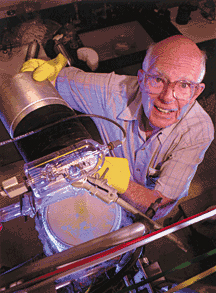
More than three decades ago, Dr. Raymond Davis Jr. Hon’90 built a tank deep inside a South Dakota gold mine and filled it with perchloroethylene, a dry-cleaning fluid containing chlorine atoms, in the hopes that some of those atoms would react with some of the billions of solar neutrinos that quietly bombard the earth every second. Last month, the research professor of physics and astronomy was honored with the 2001 National Medal of Science for his experiment, the first to confirm the existence of these elusive subatomic particles that continue to intrigue physicists for what they tell us about our sun—and the nature of matter itself.
“I had heard of the award,” said the 86-year-old Davis, when reached by phone at his home in Blue Point, N.Y., “but I didn’t think I would ever get it, so I was quite surprised.” The National Medal of Science honors pioneering scientific research that has enhanced our basic understanding of life and the world around us. (Last year, another Penn scientist—Dr. Ralph Hirschmann, the Rao Makineni Professor of Bioorganic Chemistry—won the 2000 National Medal of Science.) In 2000, Davis won the Wolf Foundation prize in physics, half of whose recipients go on to receive Nobel prizes.
In his 1960s experiment—performed while working for Brookhaven National Laboratory, and before he joined Penn’s faculty in 1985—Davis detected only a third of the number of neutrinos predicted by the standard solar model. His findings have been confirmed and elucidated by later experiments in which Penn has played a major role. [“The Particle Sleuths,” September/October 2001.]
Penn President Judith Rodin hailed Davis as a “pioneering scientist whose extraordinary research in physics has earned him the nation’s highest award for lifetime achievement in science.”




